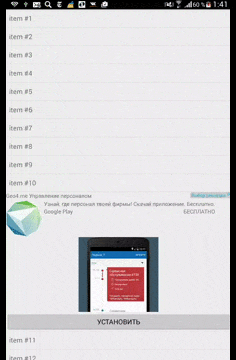Implementing native ads in android using Admob? is it possible?
Recently I stucked with the same question. Then I decided to post my solution for that to admobadapter. Hope it will help you.
The basic usage could look like:
ListView lvMessages;
AdmobAdapterWrapper adapterWrapper;
@Override
public void onCreate(Bundle savedInstanceState) {
super.onCreate(savedInstanceState);
setContentView(R.layout.activity_main);
initListViewItems();
}
/**
* Inits an adapter with items, wrapping your adapter with a {@link AdmobAdapterWrapper} and setting the listview to this wrapper
* FIRST OF ALL Please notice that the following code will work on a real devices but emulator!
*/
private void initListViewItems() {
lvMessages = (ListView) findViewById(R.id.lvMessages);
//creating your adapter, it could be a custom adapter as well
ArrayAdapter<String> adapter = new ArrayAdapter<String>(this,
android.R.layout.simple_list_item_1);
adapterWrapper = new AdmobAdapterWrapper(this);
adapterWrapper.setAdapter(adapter); //wrapping your adapter with a AdmobAdapterWrapper.
//here you can use the following string to set your custom layouts for a different types of native ads
//adapterWrapper.setInstallAdsLayoutId(R.layout.your_installad_layout);
//adapterWrapper.setcontentAdsLayoutId(R.layout.your_installad_layout);
//Sets the max count of ad blocks per dataset, by default it equals to 3 (according to the Admob's policies and rules)
adapterWrapper.setLimitOfAds(3);
//Sets the number of your data items between ad blocks, by default it equals to 10.
//You should set it according to the Admob's policies and rules which says not to
//display more than one ad block at the visible part of the screen,
// so you should choose this parameter carefully and according to your item's height and screen resolution of a target devices
adapterWrapper.setNoOfDataBetweenAds(10);
//It's a test admob ID. Please replace it with a real one only when you will be ready to deploy your product to the Release!
//Otherwise your Admob account could be banned
//String admobUnitId = getResources().getString(R.string.banner_admob_unit_id);
//adapterWrapper.setAdmobReleaseUnitId(admobUnitId);
lvMessages.setAdapter(adapterWrapper); // setting an AdmobAdapterWrapper to a ListView
//preparing the collection of data
final String sItem = "item #";
ArrayList<String> lst = new ArrayList<String>(100);
for(int i=1;i<=100;i++)
lst.add(sItem.concat(Integer.toString(i)));
//adding a collection of data to your adapter and rising the data set changed event
adapter.addAll(lst);
adapter.notifyDataSetChanged();
}
And the result will look like the following

As an addition to this thread, you can now implement NativeAds for Admob very easily by following the guide provided by Google using NativeExpressAdView . For more information, check the google documentation : https://firebase.google.com/docs/admob/android/native-express?hl=en
Native ads are included in Google Play Services along with the rest of DFP/AdMob advertising. Make sure you have the following listed as dependencies in your build.gradle (note that 7.5.0 is the highest version as of this posting).
compile "com.google.android.gms:play-services-base:7.5.0"
compile "com.google.android.gms:play-services-ads:7.5.0"
Then you can display native ads
AdLoader adLoader = new AdLoader.Builder(context, "/6499/example/native")
.forAppInstallAd(new OnAppInstallAdLoadedListener() {
@Override
public void onAppInstallAdLoaded(NativeAppInstallAd appInstallAd) {
// Show the app install ad.
}
})
.forContentAd(new OnContentAdLoadedListener() {
@Override
public void onContentAdLoaded(NativeContentAd contentAd) {
// Show the content ad.
}
})
.withAdListener(new AdListener() {
@Override
public void onAdFailedToLoad(int errorCode) {
// Handle the failure by logging, altering the UI, etc.
}
})
.withNativeAdOptions(new NativeAdOptions.Builder()
// Methods in the NativeAdOptions.Builder class can be
// used here to specify individual options settings.
.build())
.build();
Click here for complete documentation.
Try using some other ad networking where it provides different types of native ads. Developers can customize the ads where to place and use it. For eg: if you need to place ads at second cell every 15 row, you can use like this.
Avocarrot provides that.
AvocarrotInstream myAd = new AvocarrotInstream(<yourListAdapter>);
myAd.initWithKey( "<your API Key>" );
myAd.setSandbox(true);
myAd.setLogger(true ,"ALL");
// Populate with In-Stream ads
myAd.loadAdForPlacement(this, "<your Placement Name>" );
// Bind the adapter to your list view component
<yourListView>.setAdapter(myAd);// here you are integrating ads to listview
myAd.setFrequency(2,15); // every 15 cells starting from the 2nd cell.
Here is Documentation it provides List ads and Feed ads.